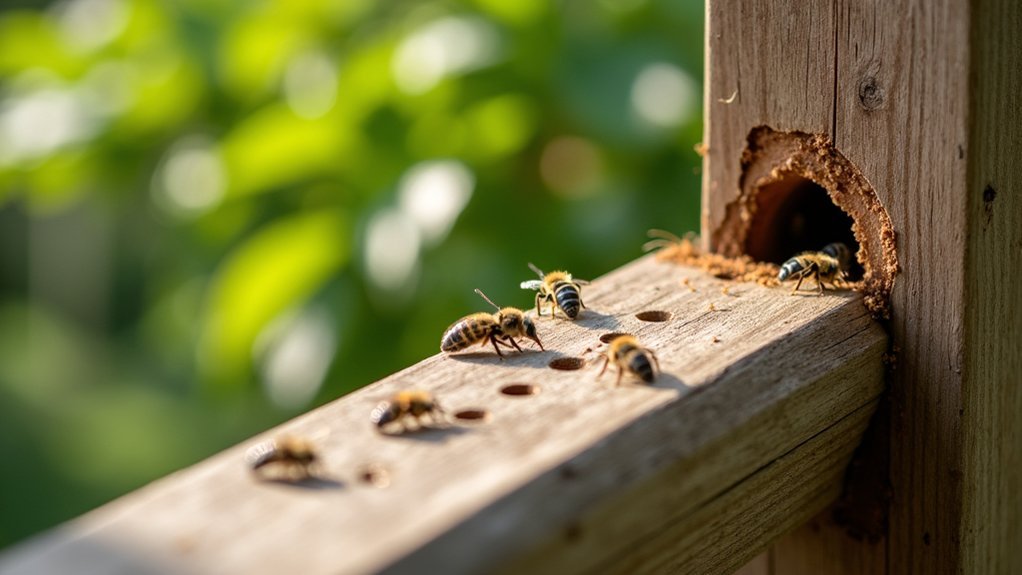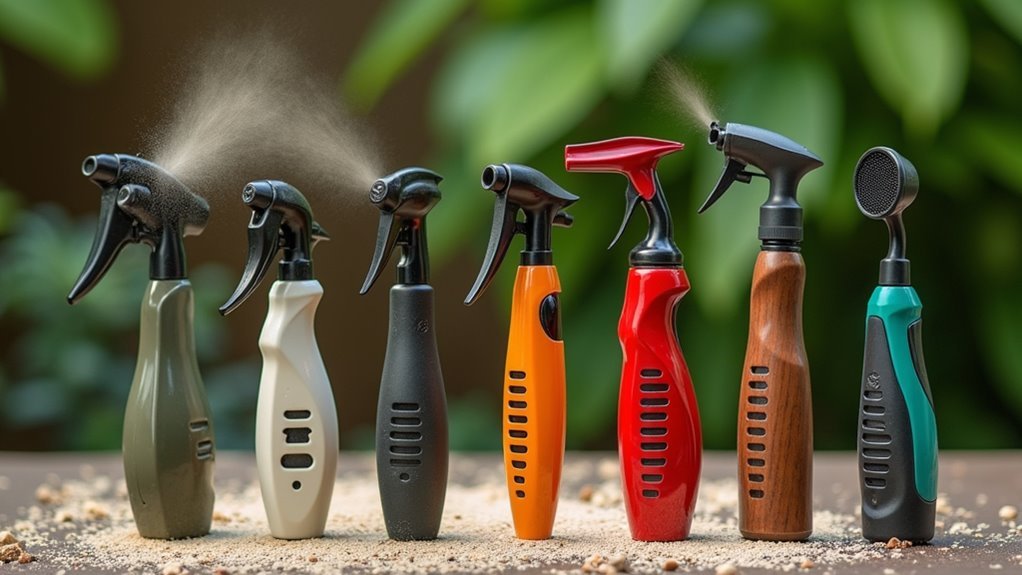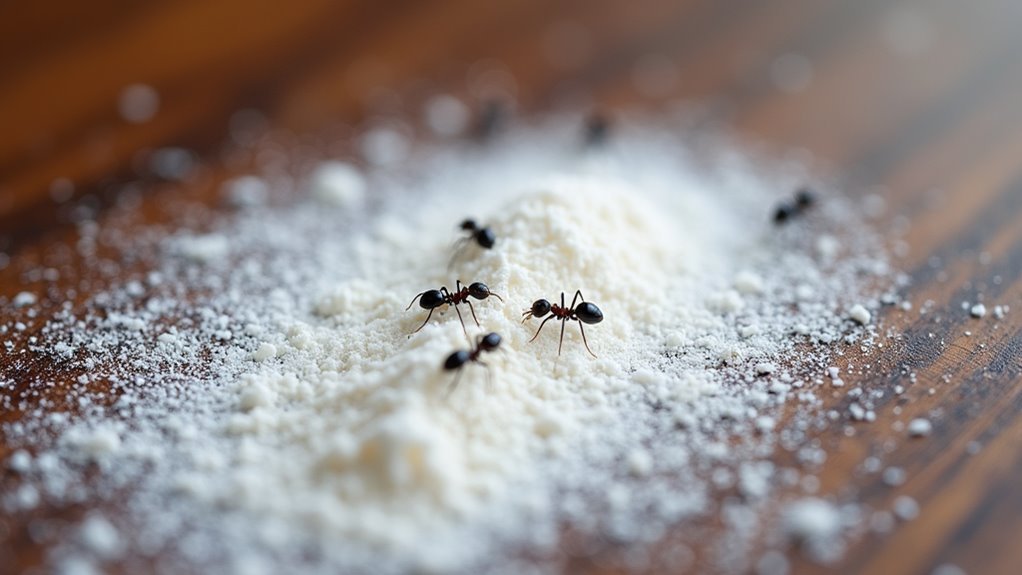Your wooden deck, fence, and home exterior deserve protection from the silent destruction of carpenter bees. These industrious insects can turn solid structures into honeycomb-like networks of damage within seasons. You’ve likely noticed those perfect circular holes appearing in your valuable wood surfaces. The right trap makes all the difference between ongoing repairs and lasting protection. Let’s explore the most effective carpenter bee traps that homeowners trust to preserve their wooden investments and stop these determined drillers in their tracks.
Best Bee Brothers Ultimate Pro Carpenter Bee Trap
Homeowners battling persistent carpenter bee infestations will find the Ultimate Pro Carpenter Bee Trap from Best Bee Brothers a chemical-free solution worth considering. This USA-made trap features a clever design with an integrated bait cup and extra-large external vault that’s visible, letting you monitor your success.
You’ll appreciate the touch-free disposal system with its 9-foot pull string that keeps you safely distanced from captured bees. For ideal results, hang the trap in sunny locations and consider adding bee bait to enhance its effectiveness. The trap’s patented behavior-based design provides protection for up to a 15-foot radius around your property.
Best For: Homeowners looking for a chemical-free solution to carpenter bee problems who want to monitor trap effectiveness and dispose of captured bees without close contact.
Pros:
- Made in the USA with a patented behavior-based design that can protect up to a 15-foot radius
- Features a visible external vault that allows you to monitor trap effectiveness without disturbance
- Includes a 9-foot pull string for safe, touch-free disposal of captured bees
Cons:
- Mixed customer reviews with some reporting issues of bees escaping from the trap
- Requires proper placement in sunny locations and may need additional bait for optimal results
- At 1.1 pounds and 7.5 inches tall, it may be more visible and heavier than some alternative traps
Carpenter Bee Trap for Outside – Pentroof Style (2 Pack)
Property owners battling persistent carpenter bee infestations will find the Pentroof Style trap a worthwhile investment. Crafted from natural cedar with a patented design, these traps incorporate a removable vault for easy disposal.
For ideal results, hang traps 5-7 feet high in direct sunlight, facing south or southwest. The cedar construction withstands all weather conditions, reinforced with screws and horse nails for durability.
Some users report immediate success, while others recommend patience. You can increase effectiveness by using dead carpenter bees as bait or adding sugar water. These traps specifically target carpenter bees without harming other beneficial insects.
Best For: Homeowners experiencing carpenter bee infestations who want an eco-friendly, chemical-free solution to protect wooden structures on their property.
Pros:
- Made from high-quality cedar with weather-resistant construction, ensuring durability through various seasons
- Features a patented design with a removable vault for easy disposal of trapped bees
- Specifically targets carpenter bees without harming beneficial insects or requiring toxic chemicals
Cons:
- Mixed effectiveness reports from customers, with some experiencing no results despite proper placement
- May require additional attractants like sugar water or dead carpenter bees to improve performance
- Takes time and patience to see results, potentially requiring multiple seasons for optimal effectiveness
Carpenter Bee Trap with Catch & Release Design
For eco-conscious individuals who want to manage carpenter bee problems without causing harm, the Catch & Release Design trap offers a humane solution. This innovative trap features a secure latch system that allows you to safely transport and relocate captured bees.
You’ll appreciate the convenience of its extra large catch chamber, typically requiring emptying just once yearly. With an effective range of 5-15 feet, it efficiently protects your wooden structures without complex maintenance.
Unlike other traps, it’s specifically designed to target only carpenter bees through pre-drilled holes, leaving beneficial pollinators unharmed. Complete with hanging hardware and five bee dams, it’s ready for immediate installation.
Best For: Environmentally-conscious homeowners looking to manage carpenter bee infestations humanely while protecting wooden structures on their property.
Pros:
- Features a humane catch-and-release design that allows for relocation of bees without harming them
- Requires minimal maintenance with an extra-large catch chamber that typically only needs emptying once a year
- Selectively targets carpenter bees while leaving beneficial pollinators like honey bees and bumblebees unaffected
Cons:
- Limited effective range of 5-15 feet may require multiple traps for larger properties
- No included lures or baits could potentially result in slower initial trapping results
- May be less effective than more aggressive extermination methods for severe infestations
Wood Wasp Carpenter Bee Traps for Outside (1 Pack Sticky Trap)
Those battling persistent carpenter bee infestations will find the Wood Wasp Carpenter Bee Sticky Trap particularly effective with its remarkable one-year protection guarantee. This innovative sticky solution, known as Bee Butter, targets not just carpenter bees but also wasps, ants, and wood ants.
You’ll appreciate how easy it is to apply—simply squeeze the product directly into active bee holes and wait about 20 minutes to see results. The included extension tube helps you reach difficult spots with precision. For best results, guarantee thorough application, and you won’t see those destructive bees return for at least a year.
Best For: Homeowners and property managers dealing with persistent carpenter bee infestations who need a long-lasting, targeted solution for active bee holes.
Pros:
- Provides extended protection lasting over a year, eliminating the need for frequent reapplications
- Includes a convenient extension tube that makes it easier to reach difficult areas and holes
- Works against multiple wood-damaging pests including carpenter bees, wasps, ants, and wood ants
Cons:
- Requires precise application directly into active bee holes for effectiveness
- Takes approximately 20 minutes to see results, which may be longer than some alternative methods
- Limited to treating existing holes rather than preventing new infestations in untreated areas
Carpenter Bee Trap for Outside – Cabin Style Wood Trap with Removable Vault
Homeowners battling carpenter bee infestations will appreciate the Cabin Style Wood Trap with its convenient removable vault system. Crafted from high-quality natural pine and reinforced with screws and horse nails, this patented design effectively stops destructive bees before they damage your property.
For ideal results, hang the trap 5-7 feet above ground in direct sunlight, facing south or southwest. The trap works best when temperatures reach 77-86°F. If bees aren’t entering initially, try using a dead carpenter bee as bait—their pheromones attract others. With a solid 4.3-star rating, this durable, weather-resistant trap offers an effective solution for protecting your wooden structures.
Best For: Homeowners with wooden structures seeking a non-toxic, easy-to-maintain solution for controlling carpenter bee infestations before structural damage occurs.
Pros:
- Patented design with removable vault makes disposing of captured bees simple and convenient
- Durable construction of high-quality pine with weather-resistant properties ensures long-lasting effectiveness
- No chemicals or pesticides required, providing an environmentally friendly pest control option
Cons:
- May require strategic placement adjustments and patience before achieving optimal results
- Some users report initial lack of effectiveness until the first bee is captured as bait
- Works best in specific temperature ranges (77-86°F), potentially limiting effectiveness in cooler climates
Original B Brothers-Carpenter Bee Trap
The patented Original B Brothers trap stands out as an environmentally conscious solution for anyone battling destructive carpenter bees. Crafted from durable hardwood with a Mason-type glass jar, this weather-resistant trap requires no messy bait—carpenter bees are naturally drawn to its yellow pine construction.
Invented by Brian and Bradley Blazer after dealing with bee damage to their own homes, this 8×5×8-inch trap combines wildlife expertise with engineering knowledge. You’ll appreciate its non-toxic design and simple setup, though you’ll need to attach the included screw hooks and chain yourself. With a 4.1-star rating from over 900 customers, it’s become a trusted defender of wood structures nationwide.
Best For: Homeowners and property managers seeking an environmentally friendly, non-toxic solution to protect wooden structures from carpenter bee damage without using chemical pesticides.
Pros:
- Made from durable hardwood and glass materials that withstand outdoor conditions while attracting carpenter bees naturally
- Requires no bait or chemicals, making it a safe option for homes with children, pets, or environmental concerns
- Designed by experienced inventors who developed the trap based on real-world experience with carpenter bee problems
Cons:
- Some assembly required, including attaching hooks and chain, which might be challenging for less handy users
- Mixed effectiveness reported in customer reviews, with some users catching many bees while others caught none
- At 3 pounds with glass components, it may be heavier and more fragile than plastic alternatives
Qualirey Wood Carpenter Bee Traps with Solar Lights (2 Pack)
Struggling with persistent carpenter bee problems? Qualirey’s pine wood traps might catch your eye with their innovative solar lights that create a 15-foot attraction radius. The natural pine construction is designed to attract carpenter bees while blending aesthetically with your outdoor space.
These lightweight traps feature ventilation holes to improve airflow and release pheromones for better effectiveness. However, buyer beware—with a 1.8/5 star rating, customers frequently report structural defects, ineffective trapping, and malfunctioning solar components. While the concept seems promising, the execution appears to fall short for most users seeking reliable carpenter bee control.
Best For: Homeowners looking for an eco-friendly, non-toxic carpenter bee trap with aesthetic appeal who are willing to take a chance despite mixed reviews.
Pros:
- Natural pine wood construction blends attractively with outdoor environments while naturally attracting carpenter bees
- Solar-powered lights create a 15-foot attraction radius to potentially improve trapping success
- Lightweight design allows for easy installation and repositioning in different areas of your property
Cons:
- Extremely low customer satisfaction with only 1.8 out of 5 stars based on customer reviews
- Frequent reports of structural defects and poor overall build quality
- Solar light components commonly malfunction according to customer feedback
3 Pack Solar Bee and Wasp Traps for Outdoor Use
Gardeners and outdoor enthusiasts seeking an effective solution for wasp problems will appreciate this 3-pack of solar-powered traps that combine functionality with convenience. These durable traps, available in green and orange, effectively catch wasps, hornets, and other flying pests without harming bees.
Setup is straightforward—simply add sugar water or beer as bait and hang in insect-prone areas. The solar-powered LED lights activate at night, enhancing their attractiveness to pests. With dimensions of 3.5 x 4.54 x 3.5 inches, they’re suitable for gardens, orchards, and farms.
Users report quick results and easy maintenance. When full, just clean with soap and water and reuse throughout wasp season.
Best For: Homeowners and gardeners seeking an eco-friendly, reusable solution to control wasps and other flying pests in outdoor spaces without harming beneficial bees.
Pros:
- Solar-powered LED lights enhance nighttime effectiveness, attracting insects around the clock without requiring batteries or electricity
- Easy setup and maintenance with simple refilling and cleaning process that takes just minutes
- Durable design allows for season-long use from spring through fall in various outdoor settings
Cons:
- May attract non-target insects like flies and fruit flies along with the intended wasp targets
- Requires regular monitoring and bait replenishment to maintain effectiveness throughout the season
- Mixed customer reviews (3.9/5 stars) suggest inconsistent results depending on location and pest populations
Best Bee Brothers Ultimate Carpenter Bee Trap with Clear Bee Vault
Homeowners battling persistent carpenter bee infestations will find the Best Bee Brothers Ultimate Carpenter Bee Trap a notable contender in the pest control market. This Chinese-made trap features a patented design that covers a 15-foot radius with its behavior-based attraction system.
You’ll appreciate the clear bee vault that lets you monitor captures and the spring-loaded door with 9-foot pull string for touch-free disposal. The integrated bait cup and aerated design help release pheromones to lure bees without harmful chemicals.
While assembly takes just a minute, be aware of mixed reviews (3.3/5 stars) regarding quality and effectiveness.
Best For: Homeowners dealing with carpenter bee problems who want a chemical-free monitoring solution that allows for easy disposal without direct contact with captured bees.
Pros:
- Clear external vault provides visibility of trapped bees, letting you monitor effectiveness without disturbance
- Touch-free disposal system with 9-foot pull string enables safe removal of captured bees from hanging locations
- Chemical-free design makes it safer for families, pets, and environmentally conscious homeowners
Cons:
- Inconsistent effectiveness reported by users, with some finding it attracts few or no bees
- Quality concerns regarding component alignment and fit during assembly
- 3.3/5 star rating suggests performance may not justify the investment for all users
Carpenter Bee Trap for Outside (2 Pack Wood Trap with Removable Jar)
The patented design of this two-pack wood trap offers an effective solution for property owners who need to protect their wooden structures from carpenter bee damage. Crafted from natural pine and reinforced with screws and horse nails, these traps stand up to all weather conditions.
For ideal results, hang your traps 5-7 feet above ground where they’ll receive direct sunlight, preferably facing south or southwest. The traps work best when temperatures reach 77-86°F. If bees aren’t entering, try corking nearby holes or relocating the traps. Dead carpenter bees inside the trap actually help attract more bees through pheromone release.
Best For: Homeowners with wooden structures seeking an environmentally friendly way to control carpenter bee infestations without using pesticides.
Pros:
- Patented design effectively traps carpenter bees before they can damage valuable wooden structures
- Durable pine construction with reinforced screws and horse nails ensures long-lasting performance in all weather conditions
- Simple to use with removable collection jars that make disposal or relocation of captured bees straightforward
Cons:
- Requires optimal placement in direct sunlight at specific heights (5-7 feet) for maximum effectiveness
- May need troubleshooting or repositioning if bees don’t initially enter the traps
- Works best in warmer temperatures (77-86°F), potentially limiting effectiveness in cooler climates or seasons
Factors to Consider When Choosing Top-Rated Carpenter Bee Traps That Save Wood Structures
When selecting the most effective carpenter bee traps for your property, you’ll need to evaluate several critical factors that determine success. You should consider trap design effectiveness, material durability against outdoor elements, specific placement requirements for maximum capture rates, and various bait attraction methods that lure bees into the trap. These considerations will help you protect your valuable wood structures while efficiently managing carpenter bee populations around your home.
SUBHEADING DISCUSSION POINTS
Selecting the right carpenter bee trap can mean the difference between protecting your valuable wooden structures and facing costly repairs. Look for traps with patented designs featuring removable vaults that make disposing of captured bees simple and efficient.
Durability matters—choose traps constructed from weather-resistant materials with reinforced screws that will withstand outdoor conditions year after year. Proper placement is essential: hang your traps 5-7 feet high in direct sunlight, preferably facing south or southwest for maximum effectiveness.
For enhanced results, consider using dead carpenter bees as bait. Their natural pheromones attract other bees, greatly improving your catch rate. Finally, don’t overlook customer ratings and reviews that demonstrate real-world effectiveness and maintenance requirements before making your investment.
Trap Design Effectiveness
Effective carpenter bee traps rely on sophisticated engineering principles that mimic natural nesting environments while ensuring capture efficiency. Look for traps featuring patented mechanisms that utilize pheromones and sounds to lure bees naturally.
You’ll want designs with visible catch chambers that allow you to monitor success and maintain your trap properly. Weather resistance is vital—select models made from high-quality wood reinforced with screws to withstand various outdoor conditions.
Placement dramatically impacts effectiveness. Install your trap 5-7 feet high, facing south or southwest in direct sunlight to maximize bee activity. For enhanced results, consider using natural bait like dead carpenter bees, which exploits territorial behaviors and greatly improves capture rates.
The most effective traps combine these design elements with easy installation and minimal maintenance requirements.
Material Durability
The foundation of a reliable carpenter bee trap lies in its material composition, which greatly impacts both longevity and performance. You’ll want to select traps crafted from high-quality natural cedar or pine, as these woods naturally withstand harsh weather conditions while remaining attractive to carpenter bees.
Look for traps reinforced with screws and nails rather than glue alone, as this construction method considerably enhances structural integrity. Weather-resistant designs featuring protective coatings or treatments will guarantee your trap remains functional through rain, sun, and seasonal changes.
For easier maintenance—which directly affects durability—choose models with removable components like collection jars. This design allows you to clean the trap thoroughly without damaging its structure. Patented designs that effectively capture bees while minimizing structural stress will provide the longest service life for your investment.
Placement Requirements
Proper placement of carpenter bee traps dramatically influences their effectiveness and can mean the difference between success and failure in your bee management efforts. For optimal outcomes, hang your traps 5-7 feet above ground where they’re most visible to these wood-boring insects.
Position traps facing south or southwest to maximize sun exposure, as carpenter bees are most active in temperatures between 77-86°F. Direct sunlight is essential for attraction, so install traps near wooden structures, eaves, patios, or decks where bees typically congregate.
Be mindful of ground moisture when choosing locations; excessive dampness can compromise trap integrity and performance. For a powerful attractant, consider using dead carpenter bees as bait – their pheromones naturally draw live bees into the trap, greatly improving your capture rate.
Bait Attraction Methods
Selecting the right bait attraction method greatly enhances your carpenter bee trap’s performance while protecting valuable wooden structures from damage. For best results, consider using dead carpenter bees as bait—their natural pheromones effectively lure other bees seeking similar nesting sites.
You’ll find sugar water or commercial bee bait particularly effective, as these sweet substances appeal to carpenter bees’ foraging instincts. Position your traps in sunny locations, preferably facing south or southwest, where temperatures reach 77-86°F—ideal conditions for bee activity.
Don’t overlook the power of color in your trapping strategy. Yellow paper placed near traps serves as a visual attractant for these wood-boring pests. For maximum visibility, install traps 5-7 feet above ground level, ensuring they’re easily accessible to flying bees while remaining in their natural flight path.
Frequently Asked Questions
How Long Does It Take to See Results From Carpenter Bee Traps?
You’ll typically see results from carpenter bee traps within 1-3 weeks. Your success depends on trap placement, seasonal activity, and existing infestation levels. Don’t worry if it’s not immediate—they’re still working!
Can Carpenter Bee Traps Harm Other Beneficial Pollinators?
Carpenter bee traps can potentially harm beneficial pollinators if they’re not properly designed. You’ll want to choose traps specifically targeting carpenter bees through size and attractants to minimize risks to other helpful insects.
When Is the Best Time of Year to Install Bee Traps?
You’ll want to install carpenter bee traps in early spring (March-April) when bees emerge from hibernation. They’re most active then and seeking nesting sites, making it the perfect time for effective trapping.
Do I Need to Use Bait in Carpenter Bee Traps?
No, you don’t need bait in carpenter bee traps. They’re naturally attracted to the trap’s design—dark holes that mimic nesting sites. Some traps include attractants, but they’ll work effectively without additional bait.
How Far Should Traps Be Placed From Affected Wooden Structures?
Place your carpenter bee traps 5-10 feet from affected wood structures. You’ll want them close enough to intercept bees but not so close that they’re drawn to the structure instead of the trap.





Leave a Reply